Now That Everyone’s a School Designer

The Crisis
As coronavirus surges through the nation, 46 states have closed their schools, impacting over 53 million students. Educators have been laboring heroically to design remote learning opportunities, and online curriculum providers are making their offerings free during the pandemic. The daily effort of ensuring that students learn, however, falls on the backs of families. Suddenly, everyone is a (home) school designer.
Almost overnight, school has shifted from a stable, brick-and-mortar institution organized and staffed by experts, to a stretch of empty time that each family must design to meet their own particular needs and constraints. This is a daunting undertaking for the most privileged of families, let alone those who are overburdened by the everyday urgencies of this moment. Illness prevention, caregiving, rent and food, and work (or increasingly, the absence of work) intersect to increase the stress of the moment.
HUMOR + INSPIRATION
Parents around the world are experiencing instant empathy for educators. After exactly 71 minutes of homeschooling, Shonda Rhimes, who in 2015 juggled four different prime-time tv shows in full production, tweeted her appreciation for teachers’ undervalued work. Her tweet was liked over 581,000 times in 24 hours.
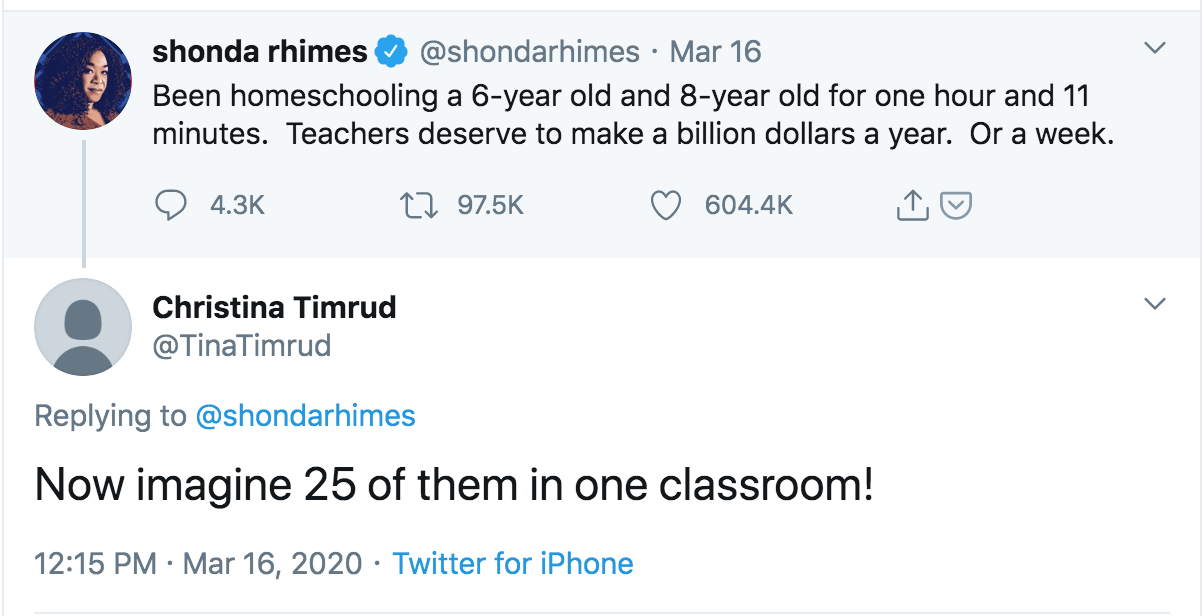
Families find themselves rolling up their sleeves and engaging with the complexity that educators face every day. They’re grappling with questions like: How do I create a manageable schedule and routine? What content and activities should my children engage in? How do I determine whether they’re actually learning? What curricula and technologies are available, and how do I access and use them? How do I handle discipline? How do I create room for my children’s physical, emotional, and social needs? (And what about my own needs?!)
Social media is overflowing with school-at-home schedules, ideas for entertaining and educating children of different ages, evidence of work accomplished, and seemingly endless lists of tools and best practices, plus a few recipes for “quarantinis” to get you through the daily struggle. Using hashtags like #LearnEverywhere, #keeplearning, #homeschool, #remoteteaching, and #remotelearning, parents and caregivers, as well as educators, are sharing humor alongside resources and ideas.
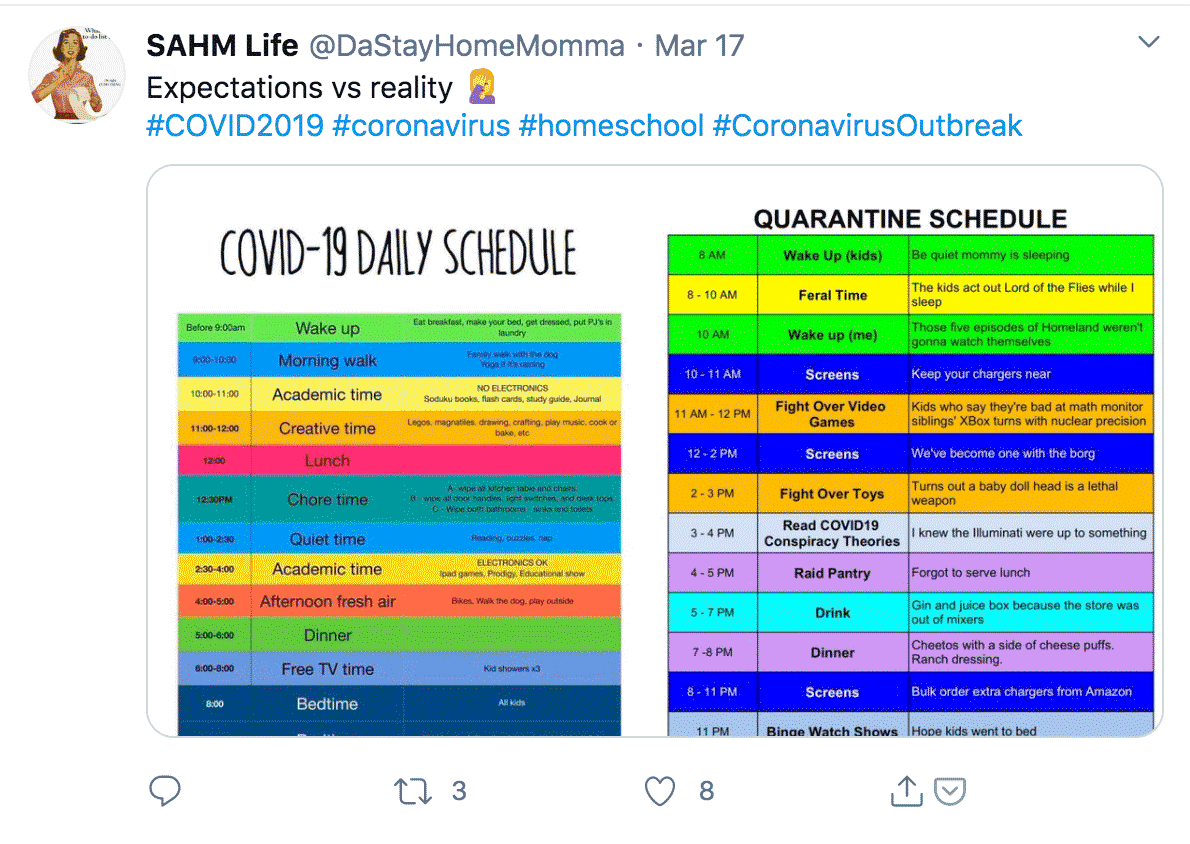
The creativity, camaraderie, and initiative displayed by families is inspiring. The humor, meanwhile, reveals the tension in trying to replicate the complex work of school within the confines of a pandemic-surrounded home school.
Within a few days of families launching their home schools, we began seeing the first evidence of parents throwing up their hands and vowing not to school (video games and cookies please!) or humorously announcing the closure of their home schools.
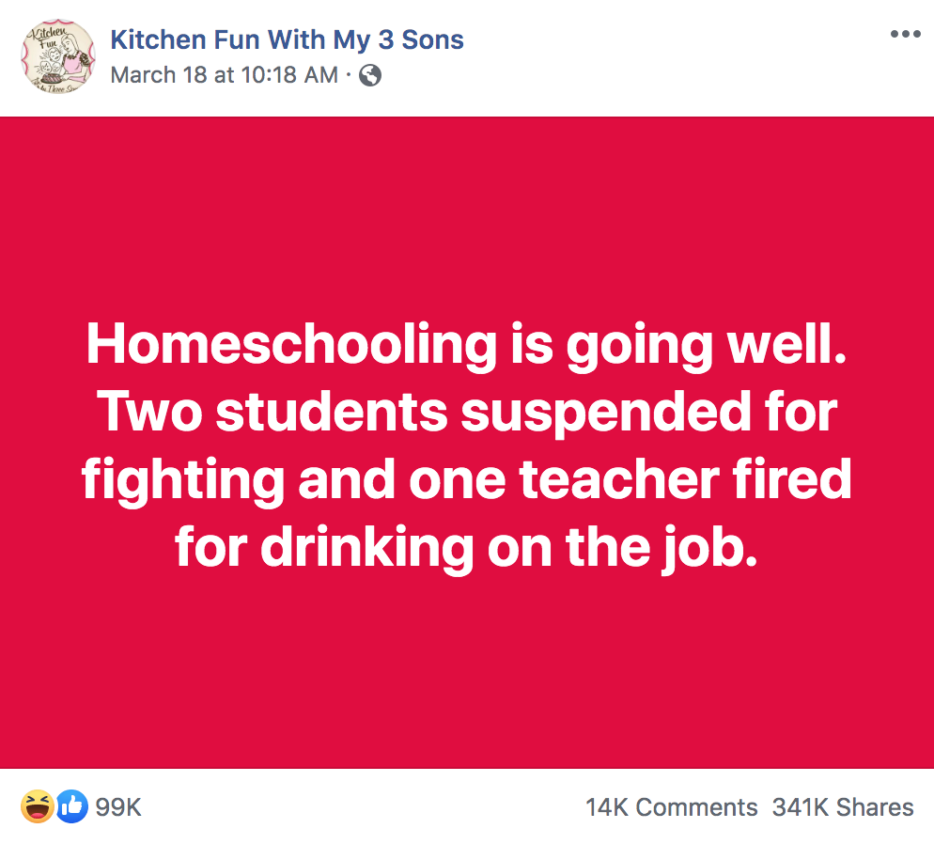
What if, between the two polarities of replicating school at home and throwing up our collective hands, there was a third way? What if we made the most of this time where kids are learning from home by using it as an opportunity to press pause, take a step back, and focus on what really matters?
What Really Matters
This crisis is an opportunity for families and educators to come together and think about learning differently. How might we together move beyond the traditional design of school, with its one-size-fits-all scope and sequence, its daily grind of schedules and regulations? We think this crisis is an opportunity to discover what really matters: nurturing young people’s curiosity, passion, and blossoming identities.
Great educators do this daily as they design learning environments. Some do it instinctively; others draw on a growing body of evidence on how humans learn.
We want to distill three of the most important pieces of that evidence—on motivation, cognition, and identity development, three key factors that impact learning—into a simple, usable guide that parents and educators can draw on in the coming months. Think of this as a bite-sized research appetizer to go with your quarantini!
- MOTIVATION— THE DESIRE TO ENGAGE WITH LEARNING IN THE FIRST PLACE—MAY BE DIFFICULT WHEN CHILDREN ARE AT HOME WITH THEIR BEDS, VIDEO GAMES, AND PUPPY. WE’VE ALL EXPERIENCED THE MYSTERY OF MOTIVATION, HOW IT COMES AND GOES, HOW IT’S DIFFERENT IN EVERY PERSON (AT DIFFERENT TIMES).
RESEARCH BITE: For children (and adults!) to feel motivated, they need to see value in the work they’re doing, believe they can be successful at it, have some control of the process of learning, and limit excessive stress and anxiety. - COGNITIVE WORK—SCIENCE TEACHES US THAT FOR SOMEONE TOLEARN SOMETHING NEW, IT NEEDS TO MOVE BEYOND SHORT-TERM, “WORKING MEMORY” SO IT CAN STICK IN LONG-TERM MEMORY. THIS IS HARDER THAN IT SOUNDS, AND PARTICULARLY HARD IN A HOME ENVIRONMENT (SEE PUPPIES, ABOVE).
RESEARCH BITE: Learning requires making connections, engaging in focused and bite-sized intervals of practice, receiving feedback on how one can improve, and reflecting on one’s own thinking. - IDENTITY DEVELOPMENT—CHILDHOOD AND ADOLESCENCE ARE TIMES OF FLUID IDENTITIES WHEN YOUNG PEOPLE QUESTION AND GRAPPLE WITH WHO THEY ARE BECOMING. THIS CORE DEVELOPMENTAL TASK IS DIFFICULT UNDER THE BEST OF CIRCUMSTANCES, BUT CAN FEEL ESPECIALLY OVERWHELMING WHEN NORMAL ROUTINES ARE UPENDED AND THE WORLD SEEMS FILLED WITH UNCERTAINTY.
RESEARCH BITE: Each child has unique strengths, interests, and needs, as well as a personal identity that matters deeply. Helping each child to find their just-right approach will maximize the chances of success.
Putting it All Together
So how can you put the research bites to use without exhausting yourself as many family members are? First and foremost, bring your young learner(s) in as a co-designer and try the following choices.
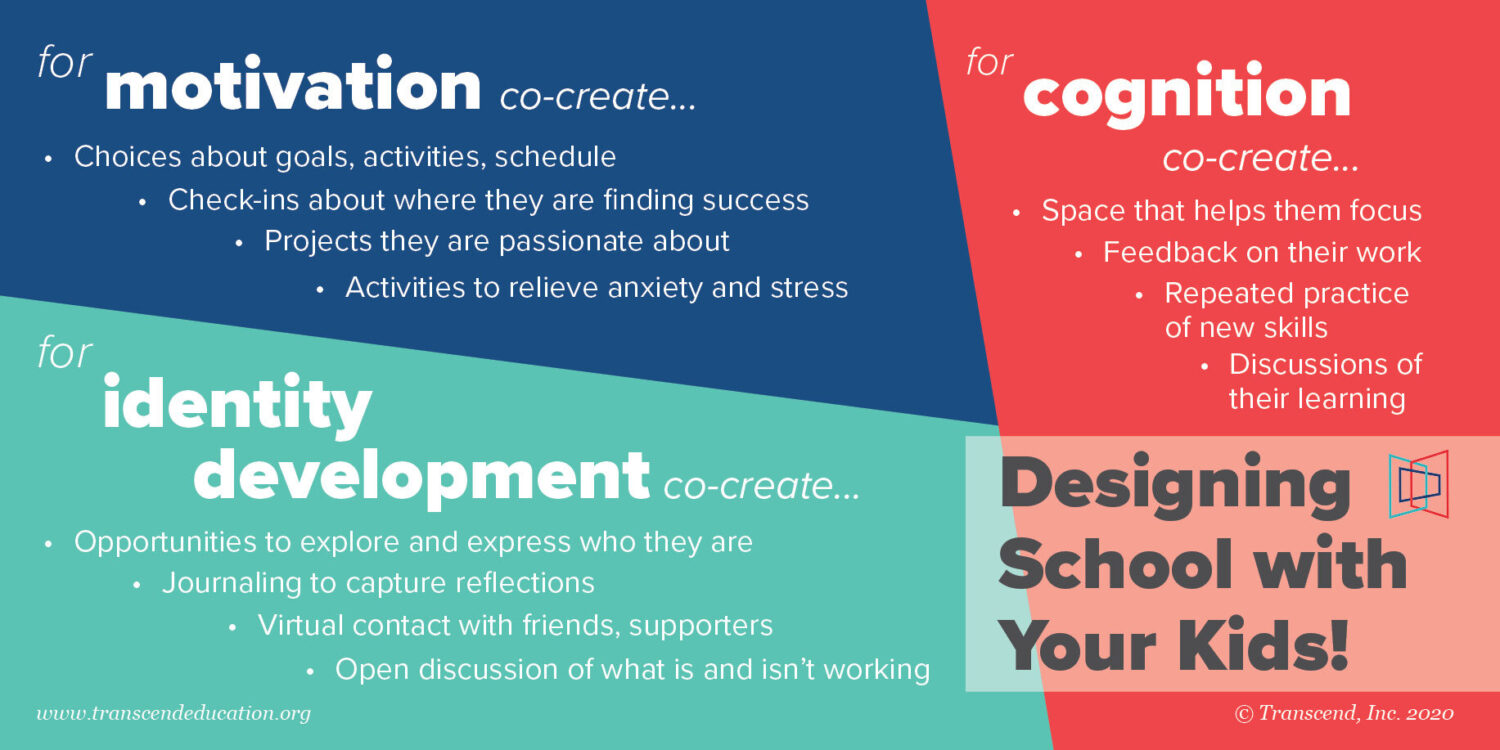
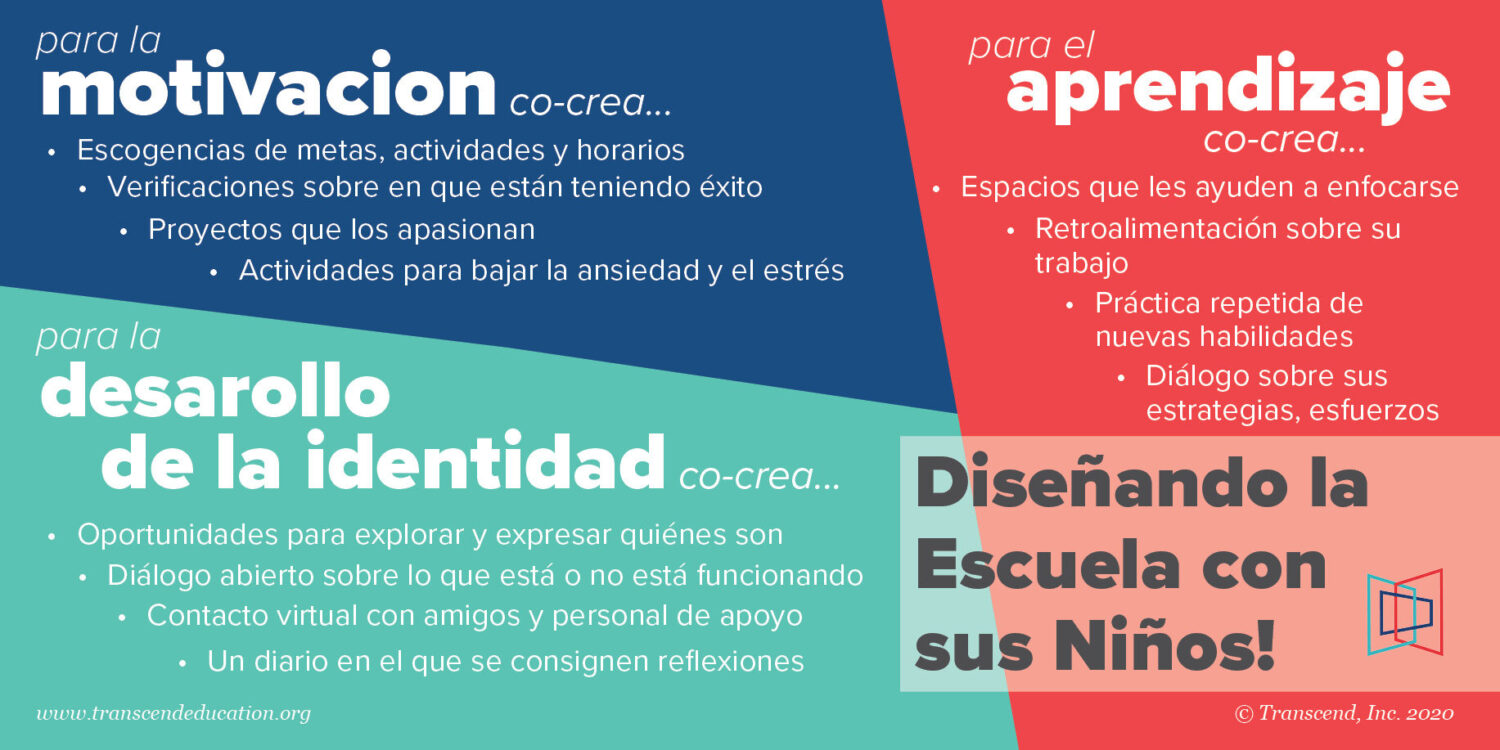
If you have more than one child, you already know that no two kids are alike. Developmental science highlights the many ways in which each learner is unique, with a “jagged profile” of strengths, motivations, learning differences, prior knowledge, passions, and anxieties. Some learners thrive with structure while others need free space; some absorb instructional videos like sponges while others need to grapple with ideas through conversation; some will finish schoolwork in 30 minutes while others need six hours; some benefit from fewer distractions while others crave social stimulation. Each of your children may need a unique (home) school design, but the co-design ideas above—by bringing your child into the designing process with you—lift some of the burden.
Still, at this point, you’re probably Googling the quarantini recipe…
OUR Future
Please do make the quarantini, and settle in with it! Give yourself that space for stress relief and reflection. As you and your children repeatedly practice the choices above, as you together explore your successes and discuss feelings and what’s working (or not), you and your children will deepen your empathy for teachers.
Because this only scratches the surface of educators’ daily work.
You’ll gain insight into what it means to design for a school of 500 learners whose individual jagged profiles include a wide range of developmental readiness levels, trauma, home languages other than English, learning differences, personalities, and more. Is this even possible? We don’t think so, as school is currently structured.
Schools as we and our children know them were designed to smooth over all these jagged variables. They were created in the late 19th and early 20th centuries as a response to industrialization, an era of mass production that prioritized efficiency, centralization, and uniformity. This now archaic system has worked for those whose identity development, motivation, and cognitive processes happen to fit well with its methods and rules, while those who don’t fit often drop out, and a vast middle of learners are forced to spend 35 hours per week enduring learning environments that were designed with a hundred-year-old understanding of how children learn best.
We as a nation have been trapped in a conversation about failing schools for many decades. With most schools closed and so many of us confronting the complexity of educators’ work firsthand, we cannot, when we emerge from this crisis, return to the mass schooling model that serves the needs of only some children. What could schools look like that are based on the individuality of learners—their jagged profiles—and that are grounded in the science of how we support motivation, cognition, and identity development?
This is the great challenge and opportunity on the other side of the coronavirus crisis. We owe it to our children, our educators, and ourselves not to waste it.
Jeff Wetzler is co-founder of Transcend, where Sujata Bhatt is a Senior Fellow, Cynthia Leck is Head of Research, and David Nitkin is Head of Measurement. Transcend is a national nonprofit that supports communities to create and spread extraordinary, equitable learning environments. Jeff has two middle school-aged children who are following a “Corona School” that his family designed.
Transcend supports communities to create and spread extraordinary, equitable learning environments.

